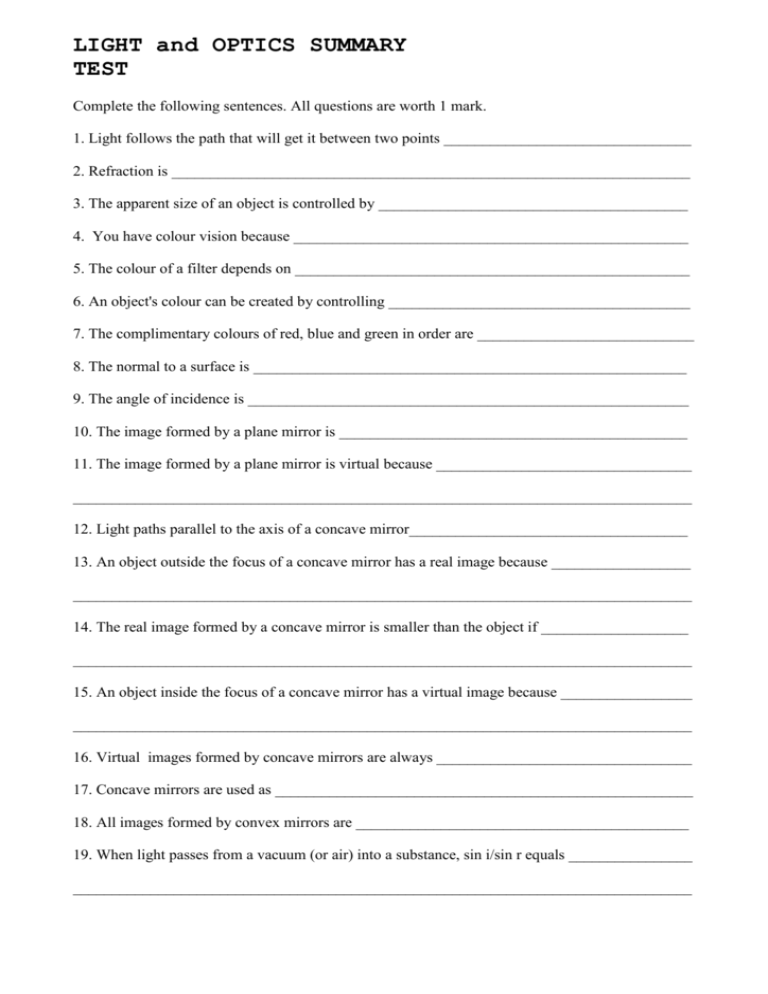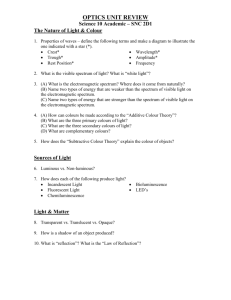refractive parallel
advertisement

LIGHT and OPTICS SUMMARY TEST Complete the following sentences. All questions are worth 1 mark. 1. Light follows the path that will get it between two points ________________________________ 2. Refraction is ___________________________________________________________________ 3. The apparent size of an object is controlled by ________________________________________ 4. You have colour vision because ___________________________________________________ 5. The colour of a filter depends on ___________________________________________________ 6. An object's colour can be created by controlling _______________________________________ 7. The complimentary colours of red, blue and green in order are ____________________________ 8. The normal to a surface is ________________________________________________________ 9. The angle of incidence is _________________________________________________________ 10. The image formed by a plane mirror is _____________________________________________ 11. The image formed by a plane mirror is virtual because _________________________________ ________________________________________________________________________________ 12. Light paths parallel to the axis of a concave mirror____________________________________ 13. An object outside the focus of a concave mirror has a real image because __________________ ________________________________________________________________________________ 14. The real image formed by a concave mirror is smaller than the object if ___________________ ________________________________________________________________________________ 15. An object inside the focus of a concave mirror has a virtual image because _________________ ________________________________________________________________________________ 16. Virtual images formed by concave mirrors are always _________________________________ 17. Concave mirrors are used as ______________________________________________________ 18. All images formed by convex mirrors are ___________________________________________ 19. When light passes from a vacuum (or air) into a substance, sin i/sin r equals ________________ ________________________________________________________________________________ 2. 20. When light passes into a higher refractive index substance, it ____________________________ ________________________________________________________________________________ 21. The speed of light in a substance equals _____________________________________________ ________________________________________________________________________________ 22. The greater the difference between the refractive indices of two substances ________________ ________________________________________________________________________________ The refractive index of a substance has a slightly different value for each colour of the spectrum. Each colour refracts through a slightly different angle but the difference is not obvious unless amount of diffraction is large. This is called dispersion. When dispersion occurs, red refracts the least and violet the most. 3. When light reaches a boundary some is reflected back and some is refracted into the next substance. The greater the angle of incidence the greater the amount of reflection and the less the amount of refraction. If light is approaching a substance with a lower refractive index and the refracted light lies along the boundary, the angle of incidence is called the critical angle. The sine of the critical angle equals the smaller refractive index divided by the larger refractive index. If light is approaching a substance with a lower refractive index at an angle greater than the critical angle, all of the light is refracted back into the first substance. Convex Lenses Light paths parallel to the axis refract and converge to the focus. A point source at the focus results in a reflected beam that is parallel to the axis. The distance from the focus to the centre of the lens is the focal length. The more curved the lens surface, the shorter the focal length. Light starting from a point outside the focus converges to a point after passing through the lens. An object outside the focus has a real image because light passes through the place where the image is formed. Real images formed by a single convex lens are always inverted - back to front and upside down and formed on the far side of the lens. If the object is at infinity - a few metres, the image is formed at the focus. The real image is smaller than the object if the object is more than 2 focal lengths away. The real image is the same size as the object if the object is 2 focal lengths away. The real image is bigger than the object if the object is between one and two 2 focal lengths away. The real image can be seen by looking into the lens or projected onto a screen. Light starting from a point inside the focus diverges after passing through the lens. An object inside the focus has a virtual image because light does not pass through the place where the image is formed. Refracted light seems to have come through the lens in straight lines. Virtual images formed by convex lenses are upright, enlarged and seem to be formed on the same side of the lens and further away. The virtual image can only be seen by looking into the mirror. Used as the collector of light in telescopes, cameras, microscopes and binoculars. Concave Lenses Light paths parallel to the axis refract and diverge as if all coming from a point on the same side of the lens - the focus. The distance from the focus to the centre of the lens is the focal length. The more curved the lens surface, the shorter the focal length. All objects regardless of distance have images that are virtual, upright, diminished that form on the same side of the lens between the lens and the focus. The virtual image can only be seen by looking into the lens. If the object is at infinity - a few metres, the image is formed at the focus. Used in glasses for short sighted people and the eyepiece for Opera Glasses. Ray tracing A light path parallel to the axis refracts or reflects through the focus or if coming from the focus. A light path aimed at the centre of a lens or mirror passes straight through of reflects back at the same angle to the axis. 4. Light passing through the focus or aimed at the focus travels parallel to the axis after reflecting or passing through the lens or mirror. Lens/ Curved Mirror Formula The real is positive sign convention sets real images at positive distances and virtual images at negative distances from the lens or the mirror. Heights are positive if upright and negative if inverted. Focal lengths are positive for convex lenses and concave mirrors and negative for concave lenses and convex mirrors. 1 over the object distance plus 1 over the image distance equals 1 over the focal length. Magnification equals image height divided by object height. Magnification equals the negative image distance divided by the object distance. Cameras The film is fixed so a camera is focussed by moving the lens towards or away from the film. The longer the focal length of the lens, the bigger the images it forms. The focal ratio of a lens is equal to its focal length divided by its diameter The larger the focal ratio, the less bright are the images. The field of view is the area in front of the camera that has an image recorded on the film. The shorter the focal length of the lens, the wider the field of view. The depth of field is the distance between the objects closest and furthest from the camera that are in acceptable focus for one position of the lens. The greater the focal ratio, the greater the depth of field. The exposure time is the time the image falls on the film while the shutter is open. The ASA of a film is 1 over the exposure time needed to take a good picture in bright sunshine when the focal ratio is 16. The bigger the ASA rating of a film, the less light is needed to take a good picture. Colour Photography Films and prints have layers sensitive to red, green and blue light. After developing the film or print, coloured dyes appear in the layers where these types of light were absorbed. A magenta dye is in the green sensitive layer where green light was absorbed, a cyan dye is in the red sensitive layer where red light was absorbed, a yellow dye is in the blue sensitive layer where blue light was absorbed. The dyes form filters. A magenta and yellow combination allows red light through, a magenta and cyan combination allows blue light through and a cyan and yellow combination allows green light through. The colour that appears on the negative is the complimentary colour in the original scene.








